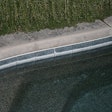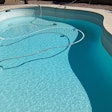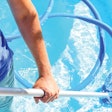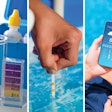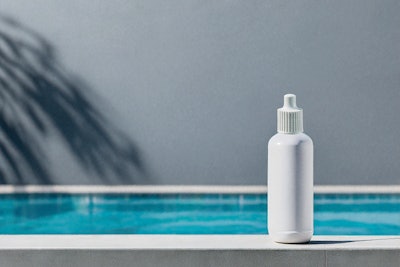
In Part 1, we discussed the importance of maintaining the free chlorine at or above 1.0 ppm to prevent infections caused by germs in the water. However, this is not the only aspect of the essential testing needed to properly maintain a body of water. To ensure that free chlorine remains effective, the pH must be monitored and adjusted. Each year, there are dozens of pH excursions that lead to chlorine gas releases. Besides free chlorine, it is essential to monitor the combined chlorine, as this large group of halogenated compounds, also known as disinfection byproducts (DBPs), are also a major source of Recreational Water Illnesses (RWIs). Although there are no available statistics on the frequency of DBP-caused RWIs, anecdotal evidence from swimmers and parents strongly suggest that DBPs cause more illnesses than germs.
In North America, the standard operating range for pH is 7.2 to 7.8. These values are the PHTA standards which are well established and applied as best practices. They are included in many state and local pool regulations. These limits balance disinfection efficacy, corrosion control and swimmer comfort.
The upper limit is based on the killing efficacy of hypochlorous acid. As pH rises above 7.5, the reduction in hypochlorous acid and subsequent increase in hypochlorite ion results in less killing power of free chlorine. In theory, increasing the free chlorine as the pH rises can maintain the same killing efficacy. For example, at pH 7.5 and 2.0 ppm free chlorine, there is 1.0 ppm of hypochlorous acid. To have the same 1.0 ppm of hypochlorous acid at pH 8.1, you would need 5.2 ppm free chlorine. However, this example does not account for the complexities of recreational water chemistry, including the impact of cyanuric acid. The simplest approach is to follow well-established standards and maintain the pH between 7.2 and 7.8. Besides, arguing about chemistry with a health inspector who is about to close the pool for being outside the legally prescribed upper limit is not likely to be an enjoyable encounter.
Elevated levels of combined chlorine cause rashes and eye irritation that typically resolve after a few hours without requiring medical treatment. There are more than 800 known DBPs in chlorinated and brominated waters. Some of these chlorinated compounds can be detected by standard DPD pool test kits. At best, the results of a combined chlorine test are an estimate of the concentration of DBPs in the water. OTO pool test kits are no better and, in another way, much worse in they only reveal the total chlorine (free plus combined).
PERSISTENT MYTH
A significant amount of research has shown that concentrations of combined chlorine often exceeded 0.4 ppm and occasionally surpassed 1.0 ppm. After the change from OTO to DPD test kits in the late 1960s and early 1970s, there was a noticeable reduction of rash reports observed in the scientific literature. This suggests that a combination of better testing methods and increased awareness has reduced the historical number of rashes from DBPs. However, one persistent myth in aquatics is that the smell of poorly managed indoor pools is due to excessive chlorine. In reality, the odor comes from several dozen well-recognized but highly odiferous volatile DBPs. Poor air quality indicates that the water contains excessive concentrations of these volatile DBPs.
While most illnesses from DBPs are minor, a limited number of people develop more severe chronic medical conditions. Chronic conditions develop over years of repeated exposure and are generally undocumented in the vast majority of swimmers. These conditions can lead to breathing issues and some investigators suggest this includes asthma. Several European studies have shown that there is a correlation between swimming and asthma. This suggests that inhaling chlorinated water vapor while swimming causes asthma. But epidemiologists say that correlation does not prove causation. In simple terms, a higher incidence rate of asthma among competitive swimmers compared to non-swimmers is not considered proof that swimming caused their asthma. An alternative explanation is that competitive swimmers may have different metabolic and immunological makeup that predisposes them to higher incidences of asthma. The jury is still out on the true cause of the association between swimming and asthma.
There is one category where DBPs are directly and positively linked with allergic reactions – severe rashes due to hypersensitization from repeated exposure to chlorinated water. Aquatic physical therapists spend several hours per day in the pool for years of their professional practice. In time, their immune system becomes hypersensitive to chlorinated, or brominated, compounds. Even when the concentration of DBPs is undetectable by conventional test kits, their immune system becomes so reactive that any exposure results in severe rashes. The only solution is to cease all exposure to halogenated water. In the case of this group, it requires a change in employment to non-aquatic jobs.
BREAKPOINT?
If high combined chlorine is bad, why not just use breakpoint to control it? Isn’t breakpoint supposed to eliminate combined chlorine? NO! Breakpoint is not designed for swimming pools! Breakpoint was discovered in the 1930s when drinking water was being treated with chlorine in combination with ammonia or an ammonia compound. Breakpoint chemistry is optimized to eliminate chlorinated ammonia compounds (mono-, di-, and trichloramine). Human perspiration and urine contain dozens of organic compounds but only trace amounts of ammonia. Each one of the organic ammonia compounds reacts slightly differently than ammonia during breakpoint. This means both the concentration of chlorine needed and the time required for reaction are different than with just simple inorganic ammonia. Since you are not able to determine the exact composition of organic compounds present, you can’t predict the required treatment dose or time required for a full “breakpoint.” The net result is that breakpoint in a pool may eliminate some of the combined chlorine but not all.
How much combined chlorine is too much? The ANSI/APSP/ICC-11 2019 American National Standard for Water Quality in Public Pools and Spas states 0.4 ppm combined chlorine is the maximum. Some individuals are much more sensitive than others. Further, some DBPs are more irritating than others, and the 0.4 ppm limit of combined chlorine may be too high for sensitive individuals. With indoor pools that have less air exchange, it may be that very low concentrations of DBPs will cause objectionable air quality. In these cases, a systematic approach to better water quality management and air exchange are needed.
RASH EFFECTS
Rashes can be caused by either elevated concentrations of combined chlorine or infections from Pseudomonas aeruginosa. In both cases, the rash is itchy and weepy. In nearly all cases, the cause can be distinguished based on the time onset of symptoms. Allergic reactions from chemical exposure begin rapidly after exposure. In many cases, chemical rashes can be noticed within a few minutes after leaving the water. At very low concentrations it may require up to 24 hours for a chemical rash to develop. Infections require the small number of bacteria that enter the skin follicle to multiply. This takes many hours or, more commonly, several days. If swimmers report rashes soon after leaving the water, test for combined chlorine concentrations. But if they report rashes a day to a week later, there may have been elevated concentrations of Pseudomonas in the water. In the first case, combined chlorine was not being controlled. In the second case, free chlorine was not being controlled. In both cases, inadequate testing led to easily preventable RWIs.
How often should you test for pH and combined chlorine? You should test for these every time you test for free chlorine. The frequency of testing will depend on the local pool code and the venue. Some codes require testing every two hours, while some counties in Georgia require HOA pools to be tested twice per week. Best practices require operators to test frequently enough so that the free chlorine, combined chlorine, and pH remain within acceptable ranges. This may require more frequent testing than specified by local codes. In certain areas, such as counties in Georgia, chlorine and pH control systems may not be capable of maintaining proper chlorine and pH levels without more frequent testing and adjustment. The bottom line is very simple: testing must be frequent enough to comply with local codes as well as maintain safe free and combined chlorine and pH levels. Ultimately, maintaining safe conditions is the responsibility of the operator.
This article first appeared in the August 2024 issue of AQUA Magazine — the top resource for retailers, builders and service pros in the pool and spa industry. Subscriptions to the print magazine are free to all industry professionals. Click here to subscribe.

































